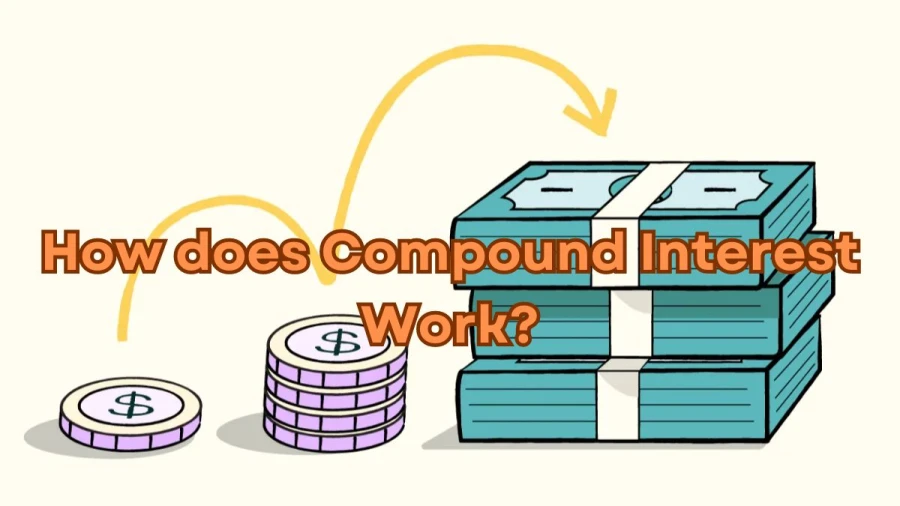
How does Compound Interest Work? 4 Methods of Compound Interest Calculation
Compound interest is like a magical savings trick where your money grows faster over time because you earn extra interest not only on your initial amount but also on the interest you've already earned.
by Kavitha
Updated Apr 08, 2024
On This Page
What is Compound Interest?
Compound interest is a form of interest that has the benefit of doubling money faster than other methods, like simple interest. To put it simply, in simple interest, the interest amount is fixed. But with compound interest, the interest amount varies over the years. That is, you’ll get interest on your primary investment like other savings methods, but after a year, along with the principal amount and interest, you’ll receive extra interest on the total amount.
Example of Simple Interest: If you are investing $1000 and the interest rate is 10%, let 1 year be the maturity period. After the period of maturity, your amount will be $1100. If you continue this method after the second year, the interest percentage will depend only on the primary amount you invested, which is $1000. So, with this method, the interest amount will never change.
Example of Compound Interest: Assume you are investing $1000 in a compound interest plan. Per year, the interest rate is 10%, so per year you’ll get $100 in interest. But coolness begins with the second year. Now you’ll have $1100 in your account after the first year. So, now your interest amount will vary depending on the amount you are currently holding. In simple terms, you’ll receive the interest amount not just for $1000 but for $1100.
How does Compound Interest Work?
Compound interest is a better way to grow money. To give you a simple idea about how it works, imagine you deposit $100 in a compound interest plan and you get interest like other savings accounts, but for instance, let’s pretend it's a special place where you’ll receive an extra 10% interest apart from the regular interest. So at the end of a year, you’ll have an extra interest amount along with your principal amount.
In the second year, everything turns super cool. You'll not only get 10% of your original $100, but you'll also get 10% of the extra $10 you earned in the first year. So, instead of just getting $10 again, you'll get $11 this time. Now, you'll have $121 in total. This continues every year. So, over time, your money starts growing faster and faster.
4 Methods of Compound Interest Calculation
Compound interest formula:
A = PV(1+i)^n - PV
A = Final amount
PV = Present value of the principal amount
i = Interest rate
n = Number of times interest compounds
How to calculate compound interest:
- Add 1% to the interest rate percentage.
- Multiply the new percentage by the tenure period.
- Multiply that amount by the present value to get the annual return.
- Finally, Subtract the annual return from the principal to determine the compound interest rate.
Compound interest calculator:
There are many ways and online platforms are present to calculate the compound interest. There is also a free online calculator including the U.S. Securities and Exchange Commission.
Spreadsheets:
Spreadsheets are also used to calculate the compound interest this helps the investors to see the maturity amount in a particular period. It's called the "future value" calculation.
The rule of 72:
You take the annual interest rate that you're getting on your investment and divide it by 72. That's it! Let’s assume you are getting a 10% interest rate on your investment of $100. Now divide 72 by 10 and you’ll get the answer around 7.2 years. So, it will take approximately 7 years to double your money.
Compound Interest Advantages and Disadvantages
The tabular column below represents the Advantages and Disadvantages;
Advantages of Compound Interest |
Disadvantages of Compound Interest |
|
Amplifies your returns |
Works best over the long-term |
|
You can start off small |
Can lead to significant debt burden |
How does Compound Interest Work? - FAQs
1. What is Compound Interest?
Compound interest is a way to grow your money faster over time by earning extra interest on both your initial investment and the interest you've already earned.
2. How does Compound Interest Work?
Compound interest works by adding extra interest each year not just on your initial investment, but also on the interest you've already earned, helping your money grow faster and faster.
3. How to Calculate Compound Interest?
To calculate compound interest, you add 1% to the interest rate, multiply it by the tenure period, and then subtract the annual return from the principal to find the compound interest rate.
4. What is the Rule of 72?
The Rule of 72 helps estimate how long it will take for your money to double by dividing 72 by the annual interest rate.




